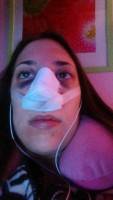Crooked nose after rhinoplasty
If there is any asymmetric swelling, or even “crookedness”, may often be adjusted after cast removed
While you will get some sense of what the nose is going to look like immediately after the “cast” is removed, you are certainly not seeing the final result at this early stage.
If there is any asymmetric swelling, or even persistent “crookedness” this may often be adjusted, if necessary, at this early stage.
Uneven swelling may represent greater attention paid to the swollen area during surgery, which will resolve soon.
The contour and symmetry will likely improve over the next 6-12 months. (Michael R. Macdonald, MD, Bay Area Facial Plastic Surgeon)
Wait for rhinoplasty swelling to subside before judging the results
Any rhinoplasty will be associated with swelling, some of which takes a full calendar year to completely subside. In the early weeks after rhinoplasty, swelling can indeed be asymmetric.
There are some, but very few, situations when a surgeon may need to perform an early intervention. In most cases, waiting is a more judicious approach.
Certainly you should discuss these concerns with your surgeon, who may be able to shed more light on your unique anatomy and the technical details of your operation. (Lara Devgan, MD, MPH, New York Plastic Surgeon)
Crooked nose after Rhinoplasty
Assuming your nose was ‘crooked’ before surgery then the surgeon would have had to address several issues.
One of the most important is the position of the nasal septum which separates the nasal passages in the midline.
Untreated septal deformities can cause post surgical twisting or deviation of the nose. Proper placement of the splint is also important as too much or too little pressure can cause an apparent deviation of the nose.
Ask your surgeon how everything went and if there were any issues that might have caused the problem you’re seeing. Rhinoplasty swelling is definitely a possibility and if so it will improve relatively quickly. (Jon F. Harrell, DO, Miami Plastic Surgeon)
Crooked nose correction
Correcting a crooked nose involves changing the underlying bone and cartilage to align all of the elements of the nose. It can be quite difficult and may require an open rhinoplasty. You need to let everything settle down to really assess the final result. Patience, however difficult, is essential to see your result and not get overly upset or react and demand more surgery too soon. (Talmage J. Raine, MD, Champaign Plastic Surgeon)
Need to wait 6 months to a year
Even though it has only been one week since your rhinoplasty surgery, and if it appears crooked, one needs to wait until the swelling has subsided. This could certainly be related to uneven and asymmetric swelling in the nose. If the patient sleeps on the left side of her face, the left side of the nose will be more swollen in the morning when they wake up.
One needs to wait at least six months to a year to give any final judgment as to whether the nose is truly crooked or not, prior to making any decisions about a revision.Blenderm tape placed on the bridge of the nose at night may help with some of the swelling. Cortizone injections in the nose and also help reduce swelling on one side of the tip and bridge. (William Portuese, MD, Seattle Facial Plastic Surgeon)
Swelling and crooked nose shape after Rhinoplasty
When the splint comes off, there is often quite a bit of swelling. Usually, the nose appears straighter at this point, but not always. You have to give it some time. (Steven Wallach, MD, Manhattan Plastic Surgeon)
Uneven swelling one week postop
It is completely normal for the nose to be swollen, and in some cases unevenly swollen, one week after your rhinoplasty. The nose is just in the early phases of healing and will continue to improve with time. About 50% of the swelling will decrease over the first couple weeks. The remainder of the swelling will slowly go down, with most resolving at one year. Be patient throughout this process and make sure that you are following up regularly with your rhinoplasty surgeon. This will ensure that they monitor your nose for any changes and address any concerns you have along the way. Best of luck. (Michael T. Somenek, MD, FACS, Washington DC Facial Plastic Surgeon)
Swelling After Rhinoplasty
Right after the cast comes off, it is very tempting to judge a rhinoplasty result. This is a natural tendency, but really should be avoided.
There is significant swelling after nasal surgery, and this can make the nose seem crooked or asymmetric. It’s best to wait a few weeks before trying to make any judgements in this regrad.
Please stay in touch with your surgeon throughout the healing process. (Evan Ransom, MD, Bay Area Facial Plastic Surgeon)
In the immediate post-operative period, it can be difficult to differentiate residual swelling from residual deformities.
If a deformity is present, it may be obvious. In most cases, residual deformities are subtle and cannot be differentiated from swelling. When this situation arises, it’s important to allow the swelling to resolve before making decisions regarding revisional surgery.
In the vast majority of patients who have noticeable residual deformities following splint removal, the cause is swelling. Occasionally, gentle pressure can facilitate symmetry in cases where asymmetry is present. This is usually not necessary.
In most patients who have residual deformities, nothing needs to be done. These deformities usually resolve with time as swelling disappears. In rare cases where deformities persist after the residual swelling resolves revisional surgery may be necessary.
When this scenario arises, we generally like to wait at least twelve months before performing secondary surgery. (Richard J. Bruneteau, MD, Omaha Plastic Surgeon)
Crooked nose after rhinoplasty
Uneven swelling is common after rhinoplasty and may be responsible for what you are seeing. In noses that are crooked, the skin has been pushed out in this position for a long time and takes on a particular shape.
When the bone and cartilage underneath is straightened, it can sometimes take some time for the skin to contract and flatten to the new level and allow the nose to appear straighter.
Swelling can also appear asymmetric and this is true when there are two sides to anything in the body, be it after facelift, eyelid lift, or any other procedure. If you favor laying on one side when you sleep, that side may frequently appear more swollen. With uneven swelling, don’t be surprised if the unevenness appears to switch sides at times. With time, apparent asymmetries should be improving, not getting worse. On the flip side, getting a crooked nose perfectly straight is difficult.
It may be that the nose is persistently crooked but it is much too early to draw this conclusion. One thing you can check that will give you some reassurance is whether the area of apparent fullness or crookedness is soft. If the tissue is spongy and compressible, then this can be attributed to swelling and will likely resolve with time. By all means, talk to your surgeon about your concerns if you are seeing something unsettling. (Jason Litner, MD, Beverly Hills Facial Plastic Surgeon)
Crooked Nose or Uneven Swelling After Rhinoplasty
After a rhinoplasty and removal of the splint there may be some uneven areas or crookedness. This is normal and may be due to asymmetric swelling or other factors. These early results can change daily. The most important rule to follow is to have your Plastic Surgeon reevaluate as you go through the post-operative period. (Paul Vitenas, Jr., MD, Houston Plastic Surgeon)
Uneven Swelling After Rhinoplasty
It is entirely normal to have a nose look uneven or more swollen on one side. The swelling will usually subside within 12-15 months. (Rod J. Rohrich, MD, Dallas Plastic Surgeon)
Crooked Nose after Rhinoplasty
Yes, there can be uneven swelling after a rhinoplasty. I tell patients that it takes 4-6 weeks for most of the swelling to go away. The remaining swelling after this period slowly goes away over the next 6-12 weeks.
I would recommend that you remain patient and hang in there and allow the swelling to resolve so that you can begin to see the longterm result. (Jonathan Pontell, MD, FACS, Philadelphia Facial Plastic Surgeon)


